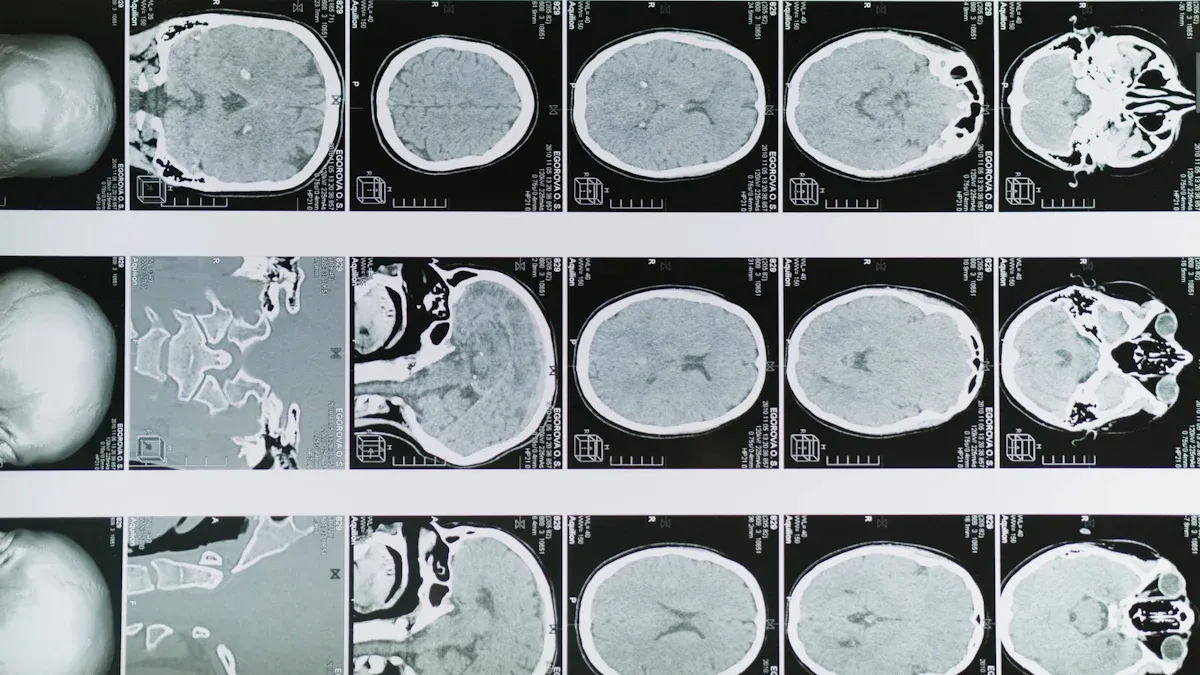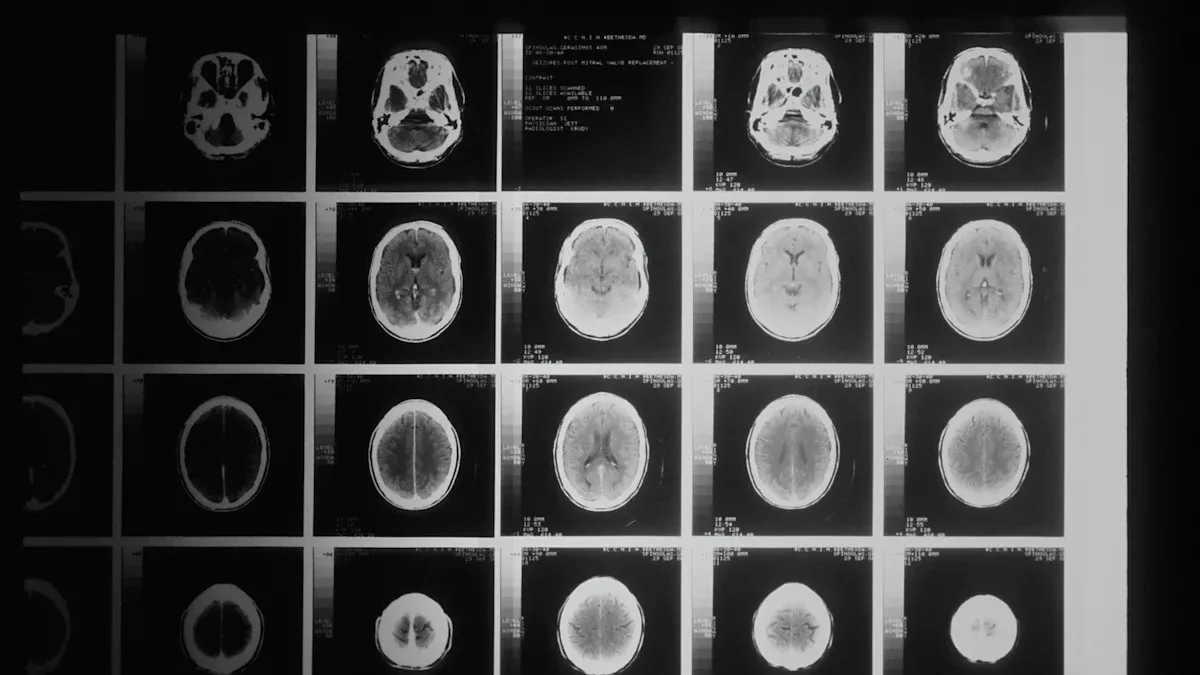Carcinoid Tumor Explained: What You Should Know

A carcinoid tumor is a rare type of cancer that grows slowly in the digestive tract. It often develops in areas like the small intestine, rectum, or appendix. These tumors belong to the neuroendocrine system, which controls hormone production in your body. You might not notice symptoms until the tumor becomes larger. Early detection plays a key role in improving treatment success. If you experience unusual digestive issues, consider consulting a healthcare provider.
Key Takeaways
Carcinoid tumors are rare cancers that grow slowly. They are mostly found in the digestive system. Finding them early helps with better treatment.
Changes in certain genes can raise the chance of getting these tumors. If your family has a history, regular doctor visits are important.
Common signs are belly pain, loose stools, and skin flushing. See a doctor if these problems don’t go away or get worse.
Doctors use scans and tissue tests to find these tumors. Catching them early makes treatment work better.
Treatments include surgery, medicines, and care to ease symptoms. Taking care of symptoms and regular check-ups help you stay healthy longer.
Causes and Risk Factors
Causes of Carcinoid Tumors
Carcinoid tumors develop from neuroendocrine cells, which exist in various organs and perform both nerve and hormone-producing functions. These cells can undergo DNA mutations, causing them to grow and divide uncontrollably. This abnormal growth leads to tumor formation. In some cases, these tumors may also release hormones, which can result in noticeable symptoms. While the exact cause of these mutations remains unclear, certain hereditary conditions increase the likelihood of developing a carcinoid tumor.
Note: If you have a family history of inherited syndromes like multiple endocrine neoplasia type 1 (MEN1), your risk may be higher. Regular check-ups can help detect potential issues early.
Risk Factors
Genetic Predispositions
Your genetic makeup plays a significant role in determining your risk. Specific gene mutations are commonly linked to carcinoid tumors, including:
MEN1 (multiple endocrine neoplasia 1)
NF1 (neurofibromatosis type 1)
VHL (Von Hippel–Lindau)
TSC1 or TSC2 (tuberous sclerosis complex 1 or 2)
If you inherit any of these mutations, your chances of developing a carcinoid tumor increase. Additionally, a family history of cancer, especially among first-degree relatives, raises your risk.
Lifestyle and Environmental Influences
Lifestyle factors, such as diet or smoking, have not been definitively linked to carcinoid tumors. Researchers continue to study whether smoking or other environmental factors contribute to their development. However, diseases that damage the stomach and reduce acid production can increase the risk of stomach carcinoid tumors.
Age and Gender Considerations
Carcinoid tumors occur more frequently in women than men. They are also more common in individuals over the age of 50. Additionally, studies show that African Americans have a higher incidence of gastrointestinal carcinoid tumors compared to other racial groups.
Tip: If you fall into any of these higher-risk categories, consider discussing screening options with your healthcare provider.
Symptoms

Common Symptoms
Abdominal pain or cramping
You may experience abdominal pain or cramping if you have a carcinoid tumor. This discomfort often occurs due to the tumor's location in the digestive tract. The pain can range from mild to severe and may worsen after eating. Persistent or unexplained abdominal pain should prompt you to seek medical advice.
Diarrhea or bowel habit changes
Changes in bowel habits, such as diarrhea, are another common symptom. You might notice frequent, loose stools or an increase in urgency. These changes occur when the tumor releases hormones that affect your digestive system. Chronic diarrhea can lead to dehydration and nutrient deficiencies, so addressing this symptom is essential.
Flushing or skin redness
Flushing is a hallmark symptom of carcinoid syndrome, which occurs in advanced cases of carcinoid tumors. About 75% of patients with carcinoid syndrome experience flushing. It often appears as a red-brown or bright red discoloration on the face, neck, or chest. Flushing episodes can last from a few minutes to several hours. Hormones released by the tumor trigger these episodes, which may worsen over time.
Note: If you notice flushing that occurs without an obvious cause, such as heat or stress, it could indicate an underlying issue.
When to Seek Medical Advice
Persistent or worsening symptoms
You should consult a healthcare provider if your symptoms persist or worsen over time. For example, abdominal pain that does not improve or diarrhea that continues for weeks may signal a more serious condition. Early evaluation can help identify the cause and guide treatment.
Symptoms affecting daily life
Symptoms that interfere with your daily activities also warrant medical attention. Chronic diarrhea or severe flushing can disrupt your routine and lower your quality of life. Addressing these issues promptly can improve your overall well-being and prevent complications.
Diagnosis
Diagnostic Methods
Physical exams and medical history
Your doctor will start by reviewing your symptoms and medical history. They may ask about persistent abdominal pain, changes in bowel habits, or flushing episodes. A physical exam can help identify any unusual masses or tenderness in your abdomen. If you have a family history of conditions like multiple endocrine neoplasia type 1 (MEN1), this information will guide further testing.
Imaging tests (e.g., CT scans, MRIs)
Imaging tests play a crucial role in detecting carcinoid tumors and assessing their spread. Commonly used methods include:
CT scans: These scans help identify tumors and check if they have spread to lymph nodes or other organs.
MRI scans: These are particularly effective for detecting liver metastases.
Gallium-68 PET/CT scans: These scans are highly sensitive for identifying low and intermediate-grade carcinoid tumors.
Imaging Test | Sensitivity | Specificity |
|---|---|---|
Somatostatin-receptor scintigraphy | 78% | N/A |
CT scanning | 82% | N/A |
111 In-DTPA octreotide imaging | 80-90% | N/A |
Blood and urine tests
Blood and urine tests can detect hormone levels associated with carcinoid tumors. Elevated levels of urinary 5-HIAA (a byproduct of serotonin) often indicate the presence of a tumor. A fasting plasma 5-HIAA assay offers a more convenient and stable alternative to 24-hour urine collection.
Confirming the Diagnosis
Biopsy procedures
A biopsy is essential for confirming a carcinoid tumor diagnosis. Doctors often use a percutaneous needle biopsy guided by imaging techniques like CT or ultrasound. This method provides a tissue sample to determine the tumor type and grade. Biopsies also help confirm whether the tumor has spread to other areas.
Endoscopic techniques
Endoscopic methods allow doctors to visualize and sample tumors in the digestive tract. Options include:
Capsule Endoscopy: This involves swallowing a small camera to view the small intestine. However, it does not allow for biopsies.
Double Balloon Enteroscopy: This technique provides detailed images and enables biopsies but requires sedation.
Endoscopic Ultrasound (EUS): EUS offers high-resolution images of tumors and nearby lymph nodes. It also allows for biopsies but carries risks related to sedation.
Tip: Early diagnosis improves treatment outcomes. If you experience persistent symptoms, consult your doctor about these diagnostic options.
Treatment Options

Surgical Treatments
Tumor removal
Surgery is often the first step in treating a carcinoid tumor. If the tumor is small and localized, your doctor may recommend removing it entirely. This procedure can prevent the tumor from spreading and reduce symptoms caused by hormone release. Early surgical intervention offers the best chance for a full recovery.
Resection of affected areas
In cases where the tumor has spread to nearby tissues, a more extensive surgery called resection may be necessary. This involves removing the tumor along with parts of the affected organ, such as a section of the intestine or liver. Resection can help control symptoms and improve your quality of life.
Non-Surgical Treatments
Medications for symptom management
Medications play a crucial role in managing symptoms caused by carcinoid tumors. Somatostatin analogs, such as octreotide and lanreotide, are commonly used. These drugs slow tumor growth and control symptoms like flushing and diarrhea.
Medication | Description | Effectiveness |
|---|---|---|
Somatostatin analogs | Related to somatostatin, helps slow neuroendocrine cell growth. | Useful for carcinoid syndrome symptoms. |
Helps treat carcinoid syndrome symptoms and may temporarily shrink tumors. | Does not cure but can alleviate symptoms. |
Targeted therapies
Targeted therapies focus on specific genes or proteins that drive tumor growth. This approach minimizes damage to healthy cells and is particularly effective for advanced cases. By disrupting the tumor's growth mechanisms, targeted therapies can slow progression and improve outcomes.
Chemotherapy or radiation for advanced cases
For advanced carcinoid tumors, chemotherapy or radiation may be necessary. These treatments aim to shrink tumors, relieve symptoms, and slow disease progression. While they are not curative, they can extend survival and improve your quality of life.
Supportive Care
Managing symptoms like pain or flushing
Supportive care focuses on improving your comfort and managing symptoms. Pain relief, flushing control, and emotional support are key components. Hospice care may also be an option for advanced cases, emphasizing quality of life over aggressive treatment.
Pain management techniques tailored to your needs.
Options for hospice care include at-home services or specialized centers.
Nutritional and lifestyle adjustments
Proper nutrition can help you manage symptoms and maintain strength during treatment. You should increase protein intake and avoid high-tyramine foods like aged cheeses to prevent flushing. If you experience diarrhea, focus on starchy, easily digestible carbohydrates and low-fat foods. Supplements may address deficiencies but should be used cautiously.
Replace vitamins A, D, E, and K if deficiencies occur.
Consider pancreatic enzymes for malabsorption issues.
Ensure adequate calorie and protein intake during chemotherapy.
Tip: Consult a dietitian to create a meal plan tailored to your needs.
Prognosis and Outcomes
Survival Rates and Recovery
Factors influencing prognosis
Several factors influence your prognosis when dealing with a carcinoid tumor. The tumor's size, location, and whether it has spread to other parts of your body play a significant role. Tumors detected early, before spreading, often have better outcomes. Additionally, the tumor's grade, which reflects how quickly the cancer cells grow, can impact recovery. Low-grade tumors tend to grow more slowly, improving survival chances. Your overall health and response to treatment also contribute to the prognosis.
Importance of early detection
Early detection significantly improves survival rates for carcinoid tumors. When diagnosed at a localized stage, the 5-year survival rate is as high as 97-98%. However, this rate drops to 55-68% if the tumor has spread to distant organs.
Stage | 5-Year Survival Rate |
|---|---|
Localized | 97-98% |
Regional | 86-96% |
Distant | 55-68% |
All Stages Combined | 89-94% |
This highlights the importance of recognizing symptoms early and seeking medical advice promptly. Regular check-ups and screenings can help detect tumors before they progress.
Life After Treatment
Long-term symptom management
After treatment, you may need to manage lingering symptoms like flushing, diarrhea, or abdominal pain. Medications such as somatostatin analogs can help control these symptoms. Nutritional adjustments, including avoiding high-tyramine foods, may also reduce discomfort. Emotional support and counseling can address the psychological impact of living with a carcinoid tumor.
Follow-up care and monitoring
Follow-up care is essential to monitor for recurrence and manage any late side effects. Your doctor may recommend yearly imaging tests for the first three years after treatment, followed by less frequent testing. For rectal tumors, sigmoidoscopy may be performed 12 months post-treatment and annually thereafter.
A survivorship care plan can guide your follow-up schedule and address potential concerns. This plan may include:
Regular imaging tests and blood work.
Monitoring for symptoms of recurrence.
Discussions about lifestyle changes to improve overall health.
Tip: Attending all follow-up appointments ensures that any issues are detected early, improving long-term outcomes.
Gastrointestinal carcinoid tumors are rare but manageable with early detection. About 8,000 cases are diagnosed annually in the U.S., most commonly in the small intestine and rectum. You can take proactive steps to reduce your risk and improve your health:
Follow a high-protein diet and avoid alcohol or symptom-triggering foods.
Practice stress management techniques like yoga or meditation.
Join a support group for emotional well-being.
If you notice persistent symptoms, consult a healthcare provider promptly. Understanding the causes, symptoms, and treatments empowers you to make informed decisions about your health.
FAQ
What is the difference between a carcinoid tumor and other types of cancer?
Carcinoid tumors grow slowly and often release hormones, causing unique symptoms like flushing or diarrhea. Other cancers may grow faster and lack these hormone-related effects. Early detection improves outcomes for both types.
Can carcinoid tumors spread to other parts of the body?
Yes, carcinoid tumors can spread, especially to the liver or lymph nodes. This process is called metastasis. Regular monitoring and early treatment help manage the spread effectively.
Are carcinoid tumors always cancerous?
Carcinoid tumors are a type of cancer, but they grow slowly. Some remain localized for years without spreading. However, they still require medical attention to prevent complications.
How can I reduce my risk of developing a carcinoid tumor?
You can’t completely prevent carcinoid tumors, but regular check-ups and a healthy lifestyle help. If you have a family history of related conditions, discuss screening options with your doctor.
Is carcinoid syndrome common in all carcinoid tumor cases?
No, carcinoid syndrome occurs in advanced cases when tumors release hormones into the bloodstream. Not all carcinoid tumors cause this condition. Early detection reduces the risk of developing carcinoid syndrome.
Tip: If you experience persistent symptoms like flushing or abdominal pain, consult your doctor for evaluation. Early action improves outcomes.
---
ℹ️ Explore more: Read our Comprehensive Guide to All Known Cancer Types for symptoms, causes, and treatments.
See Also
Key Insights Into Symptoms of Adrenocortical Carcinoma
Exploring Symptoms and Causes Associated With Anal Cancer
An In-Depth Overview of Various Cancer Types
Defining Angiosarcoma: Key Facts and Information
Exploring Symptoms and Treatment Options for Adrenocortical Adenoma
